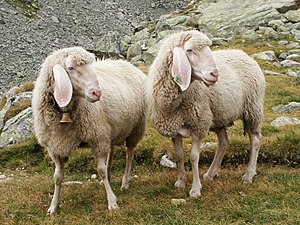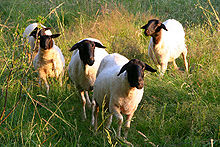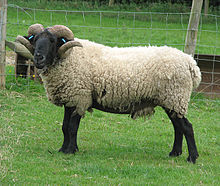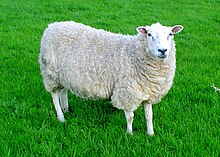Domestic sheep
| Domestic sheep | ||||||||||||
|---|---|---|---|---|---|---|---|---|---|---|---|---|

Two domestic sheep ( Ovis gmelini aries ) on a |
||||||||||||
| Systematics | ||||||||||||
|
||||||||||||
| Scientific name | ||||||||||||
| Ovis gmelini aries | ||||||||||||
| Linnaeus , 1758 |
The domestic sheep ( Ovis gmelini aries ; formerly Ovis aries Linné ), or sheep for short , is the domesticated form of the mouflon . It has played an important role in human history as a supplier of milk , lamb , mutton , wool and sheepskin .
Names of the sheep
The male animal is called the buck or ram , the female is called the ewe , Au , Aue or Zibbe . Young sheep are not only referred to as lamb , but also as yearlings or admitters . Sheep reach an age of ten to twelve, up to a maximum of 20 years. The sheep are also differentiated according to age and sex:
- Lamb : not older than a year.
- Suckling lamb: at least eight weeks old, but not older than six months.
- Lamb: up to one year.
- Mutton (Schöps): the male, castrated animal over a year old.
- Sheep, female: over a year old. With sheep is usually meant the ewe that is used for breeding.
- Bock, male: not neutered , older than a year.
From seven animals one speaks of a flock of sheep.
History of the sheep as a pet
According to earlier opinion, the short-tailed domestic sheep breeds of north-western Europe, such as the Heidschnucke , and some African breeds from the European mouflon , while the long-tailed breeds (e.g. merino, fat -tailed and fat -tailed sheep), on the other hand, developed from the Urial . On the basis of more recent findings, the view has become established that all domestic sheep breeds and types are descended from only one wild form, the Armenian mouflon . The domestication of the sheep is estimated to have taken place between 8200 and 7500 BC. BC and most likely took place in Anatolia. Sheep (as well as dogs , cattle and goats ) are among the oldest domestic animals ; they are robust and frugal. This makes them adaptable in terms of climatic conditions and food supply, which has certainly contributed to the worldwide spread of these farm animals. The original breeding largely related to the supply of meat as a food resource. Possibly from 6500 BC, sheep were also increasingly kept for their wool. This can be recognized archaeologically by the change in the age structure towards older individuals and the composition of the skeletal material in various sites. As a result, the body size also increased gradually. In the course of the expansion of the Neolithic , the domestic sheep reached around 4500 to 4000 BC. Also the North and Baltic Sea area. According to genetic studies, immigration to Central Europe took place in two ways: on the one hand via a western route via Italy and France, on the other hand via an eastern route via the Balkans and Austria. A partly held opinion about two waves of immigration from different house types, affecting animals with normal coat and those with woolly fur, could not be confirmed. Rather, it is likely that woolly sheep were independently bred several times.
A very carefully described early farm sheep is the so-called "peat sheep" of the Swiss pile dwelling settlements , which is related to various modern primitive races of the Alpine region, such as the Bündner-Oberland sheep.
Very early in the history of sheep breeding, animals of the ragged sheep type appear, which are noticeable because of their straight protruding and twisted horns. Four-horned sheep can also be found in Bronze Age populations , the outstanding feature of which is the formation of irregular additional horns. Regional sheep breeds emerged very early. The majority of the sheep breeds kept in western countries today are breeds that emerged from the 18th century. One of the most important breeders was Robert Bakewell (1725–1795), who was the first to pursue selective breeding and improve local British breeds such as the Lincoln sheep and Leicester sheep in their meat performance. Because of his success in breeding, his British contemporaries called him the "Great Improver". The sheep breeds improved by Bakewell were exported to other countries, including Australia and North America, in later decades. They have given rise to numerous modern breeds of sheep. The Texel sheep , which are mainly kept in Central and Eastern Europe, were crossed with Leicester and Lincoln sheep in particular in the middle of the 19th century. Leicester sheep were also crossed into the French Bleu du Maine . In his history of British sheep breeding, Philip Walling assumes that there is no breed of sheep in the entire western world that does not also have the genetic makeup of the Leicester sheep improved by Bakewell.
Sheep farming was a common form of agriculture in many cultures, especially in the Mediterranean region.
The sheep had a fundamental importance in the old economies and served alive as a supplier of wool and milk , milk products such as yogurt , kefir and goat cheese , and as a slaughter animal as meat - and fur -Lieferant. Sheep, for example, also provide the raw material for glue, candles and soap ( tallow ) and cosmetic products, the intestines are used in sausage production and for covering tennis rackets, and the sheep's droppings provide high-quality fertilizer.
distribution
There were 1.2 billion sheep in the world in 2018, of which around 50 percent lived in Asia. About 30 percent were native to Africa and about 10 percent to Europe . The rest was split between Oceania and America.
In Europe, the largest number of sheep lived in Great Britain with around 33 million animals in 2018. In comparison, Germany played a smaller role with 1.6 million animals in 2018. Sheep populations in the EU have been falling steadily in recent years, which is attributed to the reform of the common agricultural policy and the decoupling of premiums from production.
If one looks at the two most important production directions, meat and wool, it is noticeable that Asia mainly produces wool and Europe meat. New Zealand is at the forefront of productivity for both meat and wool. Africa has low productivity; breeds that were bred for hair or fur production are increasingly kept there.
In Germany, local sheep farming predominates. In 1994 over 34 percent of the population was kept on paddocks . The herds that shape the public image, the migrating herds and the dike sheep had a share of 15.7 and 4 percent respectively in 1994.
Todays use


In Europe, breeds that are used intensively for meat production are predominantly kept. The lamb fattening is the most important branch of sheep farming. That was not always the case: until the early 1950s, sheep in Germany were primarily bred for wool. With the displacement of sheep's wool by cotton and chemical fibers , a strong change in the direction of cultivation can be observed since then. Until then, it was the case that the wool provided around 90 percent and the lambs around ten percent of the economic yield, but the ratio has now reversed. In 1950 a kilogram of wool still cost 4.50 DM (2.30 € ), today you only have to pay around 0.50 to 0.75 € per kilogram.
In addition to breeding on wool, there is also breeding on milk production, for example in the East Frisian milk sheep or on the fur (lambs of the Karakul sheep ).
In Germany, the extensive sheep breeds are used for landscape maintenance. It preserves green areas or landscape forms such as the heather in their form and function. Without the sheep these landscapes would be stepped and forested. Sheep have a special function in protecting dikes . Not only do they prevent desertification, by stepping they strengthen the subsoil and make a direct contribution against a possible dike breach.
In Austria, sheep are used specifically on Vienna's Danube Island and - temporarily rented out - also to hold down grass on fenced-in properties, typically from 500 square meters in size.
The intestines of sheep, under the misleading name catgut for strings of musical instruments used and and tennis rackets for the production of Saitlingen . In medicine it was used as a thread for suturing wounds.
Sheep in art and culture
A diverse symbolic tradition makes sheep an object in art and culture.
The Church uses the metaphor shepherd and flock for pastor and congregation . Also note the term “lamb pious”. In Christian art, the Lamb of God , Agnus Dei , is an ancient symbol for Christ. In heraldry , it is shown together with the church flag in the coat of arms of many European communities.
In the vernacular, the sheep is often regarded as the epitome of cowardice or stupidity. Even scholars often followed this assessment. This is how the famous zoologist Alfred Brehm , author of the zoological standard work Brehms Tierleben , judged the sheep: “It understands and learns nothing [..] Its fearfulness is ridiculous, its cowardice pathetic. Every unknown noise puzzles the herd, lightning and thunder and storms and storms in general completely upset them. "
The sheep literally appears in "bringing your sheep into the dry", in "being the black sheep of the family" or "the wolf in sheep's clothing".
The meteorological singularity sheep cold is named after an aspect of keeping this animal.
In the 1978 cartoon series Die Hammlets, sheep are the characters in the story.
In 1995, the Aardman Studios created the character of an exceptionally clever sheep named Shaun ( homophonic to the English adjective for shorn / "furless sheep") in the Wallace & Gromit short film Unter Schafen. This resulted in the Shaun the Sheep series from 2007 .
Sheep in science and research
Researchers at the Babraham Institute in Cambridge found in a 2004 study that sheep can remember more than 50 faces of their own species for over two years. The study also found that hanging sheep portraits in the barn led to a significant reduction in adrenaline levels and heart rate in sheep. The researchers attributed this to the fact that the sheep "notices", i.e. perceives it in such a way that it is "not alone". The hanging up of pictures with abstract geometric shapes (such as squares or triangles) led to the opposite, i.e. to an increase in the heart rate to 113 ECG rashes, fear bleating, up to raging and panic fleeing of the herd.
In April 2006 there is an article in the British magazine New Scientist (No. 2549, p. 19) about the fact that lambs are already learning to distinguish which vegetable feed components are good for them. In the experiment, zoologists working with Juan Villalba from Utah State University first mixed substances into the feed that made the animals slightly unwell. They then remedied the young animals by giving them the necessary medication. A little later, the sheep were again given the triggering substances mixed in with the feed in a low but smellable concentration and all three previously used drugs were offered for their own selection this time. The preference for the “right” drug was significantly pronounced in each case. And in the case of repetitions, what had been learned could be proven to be anchored in long-term memory and behavior-determining for at least five months .
"If by stupid is meant the inability to learn from experience, then sheep are in no way stupid."
Sheep are also able to react “appropriately” to changing environmental influences. For example, if there is intense sunshine: If there is no other place to stand, you stand in a tight circle. Here the heads of the sheep are inside the circle; the sheep then lower their heads between their front legs to protect them from the intense sunlight. In doing so, they reduce their breathing because their activity is reduced at the same time.
Exceptional intelligence is reported in a flock of sheep in Great Britain. Animals should by it slid on his back, a three-meter-wide cattle grid have overcome, which actually represents a secure barrier for livestock
Before the development of human antisera, the sequence horse , cattle , mutton applied to the exclusively available animal sera . In this way, a sensitization through foreign protein should be avoided. This recommendation was valid until the last third of the 20th century.
Reproduction
The oestrus cycle of the female animal can be aseasonal or seasonal. The sheep season (heat season) is autumn. Out-of-season sheep are fertile year round as part of the cycles. You go through a cycle of 17 days and are receptive for two days. The gestation period of sheep is approximately 5 months (on average 150 days). The gestation time varies slightly between the individual breeds. Sheep give birth to one or two lambs, rarely triplets per pregnancy.
Sheep were artificially inseminated in the GDR from 1971 .
Diseases of the Sheep
The most common causes of death in domestic sheep in Germany are pneumonia, clostridiosis and worming. Many drugs against worm infestation ( deworming ) are only effective to a limited extent, sometimes because the widespread treatment on suspicion (without diagnosis) led to resistance.
Worms:
- Roundworms : gastrointestinal worms and lungworms
- Flatworms: tapeworms
- Flukes : liver fluke
Caused by bacteria:
Viral diseases:
- Bluetongue disease
- Foot and mouth disease
- Orf (lip grind)
- Maedi-Visna
- Jaagsiekte
- Schmallenberg virus
Other pathogens:
- Scrapie (scrapie)
- Coenurosis
Sheep breeds
The sheep breeds can be classified according to the type of wool (fleece), the purpose ( direction of use) and the degree of breeding. A distinction is made between the type of wool
- Merino-,
- Long wool,
- Short wool,
- Wool and
- Hair sheep.
The classification according to purpose is:
- Wool sheep
- Fine, mixed and coarse wool sheep
- Woolly meat sheep (so-called dual -purpose breed )
- Meat sheep: black , white and blue-headed meat sheep
- Milk sheep: East Frisian milk sheep
- Fur sheep : Karakul sheep , Gotland sheep
The breeding process is broken down into (exemplary breeds listed):
- Land sheep breeds:
- Mixed wool German country sheep and heather sheep: Heidschnucke , Bentheimer country sheep , rough wool Pomeranian sheep
- Plain German sheep : mountain sheep , Rhön sheep , East Frisian milk sheep , Black Forest sheep
- Plain sheep in the rest of Europe
- Steppe sheep (mixed wool): fat- tailed sheep , fat-tailed sheep
- Merino sheep breeds :
- Beef sheep breeds:
- English meat sheep: Lincoln sheep , Leicester Sheep , Suffolk Sheep and Dorset
- French meat sheep: Berrichon du Cher , Ile de France (sheep)
- Dutch meat sheep: Texelaar
- German meat sheep: White-headed meat sheep , black- headed meat sheep , Texel sheep
In Germany, the Merino sheep is the most common with around 30 percent. The black-headed meat sheep and the merino long wool sheep are also widespread, as are crossbreeds (see also animal breeding ) between races.
Many traditional sheep breeds that used to be widespread in Europe are now threatened with extinction because they achieve comparatively low yields as livestock. Occasionally there are re-breeding programs, e.g. B. for the stone sheep or the racket sheep .
etymology
The word “Schaf” (Middle High German schāf ) is based on Old High German scāf . There are two theories for the origin of the term.
On the one hand, Jan de Vries derived the word from the West Germanic word skēpa , which, however, does not have its origin in the Indo-European languages, instead is derived from an unspecified language.
On the other hand, Johann Knobloch , among others, saw the origin of the term in the Indo-European language, closer to the word scrape in the sense of "the shorn", which in turn is derived from the Indo-European skăb (h) (meaning: "to cut with a sharp tool"). With regard to sheep shearing, this would result in a relationship with “scheren” (from Middle High German schërn ) or “scraping” (from an Indo-European root skab ).
Trivia
The so far supposedly oldest known sheep in the world was Lucky. It died in November 2009 at the age of 23 years, six months and 28 days.
The first mammal to be cloned was Dolly the sheep . It was only seven years old.
Historically, bundled deciduous branches , which were used, among other things, to feed domestic sheep, were referred to as sheep leaves .
An extreme amount of 42 kg of wool was emergency sheared in Australia in September 2015 by a sheep that had probably not been sheared for years.
literature
- David Kennard: A shepherd's watch - through the seasons with one man and his dogs . Headline, London 2004, ISBN 0-7553-1235-X (a year in the life of a modern English sheep farmer)
- Hans Hinrich Sambraus: Color atlas of farm animal breeds . Ulmer, Stuttgart 2001, ISBN 3-8001-3219-2 (250 breeds in words and pictures)
- Gerhard Fischer, Hugo Rieder, Regina Kuhn, Fridhelm Volk: Sheep - the photo book for practice . Ulmer, Stuttgart 2004, ISBN 3-8001-4229-5 (annotated photos from all areas of sheep farming and processing of sheep products)
- Günther Dierichs: Shepherd calendar . Ulmer, Stuttgart, ISBN 3-8001-4656-8 (annually updated calendar with technical articles on a main topic as well as facts and figures)
- Christina Peter, Georg Erhardt: One sheep is like another !? The genetic diversity of Europe's sheep in the focus of molecular geneticists . In: Spiegel der Forschung 23 (2006), Heft 1/2, pp. 76–82 ( full text )
- Philip Walling: Counting Sheep - A Celebration of the Pastoral Heritage of Britain . Profile Books, London 2014, ISBN 978-1-84765-803-6 .
Web links
- Description of endangered breeds of sheep
- Sheep breeds . Entry in the register of traditional foods of the Austrian Federal Ministry for Agriculture, Regions and Tourism .
Individual evidence
- ↑ Almut Bick: The Stone Age . Theiss WissenKompakt, Stuttgart 2006. ISBN 3-8062-1996-6
- ↑ Elena A. Nikulina and Ulrich Schmölcke: The first genetic evidence for the origin of central European sheep (Ovis ammonf.aries) populations from two different routes of Neolithization and contributions to the history of woolly sheep. In: Wolfram Schier and Susan Pollock (Eds.): The Competition of Fibers: Early Textile Production in Western Asia, South-east and Central Europe (10,000-500 BC). Ancient Textiles 36, Oxbow Books, 2020
- ↑ Philip Walling: Counting Sheep . P. 43.
- ↑ Hans Hinrich Sambraus: Color atlas of farm animal breeds: 250 breeds in words and pictures , Eugen Ulmer Verlag, Stuttgart 2001, ISBN 3800132192 , pp. 112 and 133.
- ↑ Philip Walling: Counting Sheep . P. 46.
- ↑ Statistics of the Food and Agriculture Organization of the United Nations, < http://www.fao.org/faostat/en/#data/QA >, accessed on May 17, 2020
- ↑ Rental sheep erupted in Döbling orf.at, August 4, 2020, accessed August 4, 2020.
- ↑ Da Costa APC, Leigh AE, Man MS, Kendrick KM: Face pictures reduce behavioral, autonomic, endocrine and neural indices of stress and fear in sheep . In: Proceedings of the Royal Society B: Biological Sciences (2004) 271, 2077-2084. Full text (PDF)
- ↑ Quoted from Frankfurter Rundschau of April 26, 2006
- ↑ Crafty sheep conquer cattle grids . July 30, 2004 ( bbc.co.uk [accessed January 9, 2020]).
- ↑ Immune Serum - Definition. In: Gesundheit.de. Retrieved January 19, 2015 .
- ↑ Andreas Hummel: Drug theory. Vincentz Network GmbH & Co. KG, 2004, ISBN 978-3-878-70482-9 , p. 544 ( limited preview in the Google book search).
- ↑ Lambs for the Reeperbahn - Wettin and his Shepherd School , MDR, first broadcast on August 4, 2020
- ↑ Antje Hamann-Thölken: Deworming, the right way! Retrieved November 8, 2019 .
- ↑ Nicolas Schoof, Rainer Luick: Antiparasitics in grazing animals - an underestimated factor in insect death? tape 51 , no. 10 . Nature conservation and landscape planning, 2019, p. 486-492 ( researchgate.net ).
- ^ "Schaf", in: Wolfgang Pfeifer et al., Etymological Dictionary of German (1993), digitized and revised version in the Digital Dictionary of the German Language, < https://www.dwds.de/wb/Schaf > , accessed on May 17, 2020
- ↑ "Schaben", in: Wolfgang Pfeifer et al., Etymological Dictionary of German (1993), digitized version and revised by Wolfgang Pfeifer in the Digital Dictionary of the German Language, < https://www.dwds.de/wb/etymwb/ scraping >, accessed on May 17, 2020.
- ^ Friedrich Kluge , Alfred Götze : Etymological dictionary of the German language . 20th edition, ed. by Walther Mitzka , De Gruyter, Berlin / New York 1967; Reprint (“21st unchanged edition”) ibid 1975, ISBN 3-11-005709-3 , p. 631.
- ↑ Helmut Carl: The German plant and animal names: Interpretation and linguistic order. Heidelberg 1957; Reprint Heidelberg / Wiesbaden 1995, p. 202.
- ↑ AFP / dpa / lk: Record Animal: Lucky - the oldest sheep in the world is dead. In: welt.de . November 24, 2009. Retrieved October 7, 2018 .
- ↑ Sheep Chris not shorn: "I've never seen anything like it" , orf.at, September 3, 2015, accessed on September 3, 2015. - Read more> Details page.













